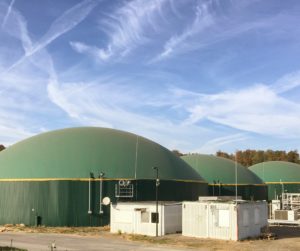What is a biogas plant and how does it work?
A biogas plant is a facility designed to convert organic matter into renewable energy through a process called anaerobic digestion. In this process, microorganisms break down organic waste in an oxygen-free environment, producing biogas—a mixture composed mainly of methane (CH₄) and carbon dioxide (CO₂).
These plants can process various types of waste, such as agricultural residues, manure, wastewater treatment sludge, and even industrial waste. The generated biogas can be used to produce electricity, heat, or even serve as fuel for vehicles, offering a sustainable solution for waste management and energy production.
In our experience working in the biogas sector, we have observed that the implementation of desulfurization systems and biogas optimization improves the quality of the produced gas, making it more efficient and useful for various applications.
How is biogas generated in a plant?
The process of generating biogas within a plant follows several stages:
- Waste Reception and Pre-treatment: Organic waste is collected and processed to remove impurities.
- Anaerobic Digestion: The waste is introduced into sealed digesters, where bacteria break down the organic matter and produce biogas.
- Biogas Purification: Impurities such as hydrogen sulfide (H₂S) and water are removed to improve the quality of the gas.
- Biogas Usage: Depending on the infrastructure, the biogas can be used to generate electricity, heat, or be injected into the natural gas grid.
Desulfurization of the biogas is a key step to ensure its efficiency and reduce pollutant emissions. In our studies and projects, we have found that using iron hydroxide is an innovative solution to eliminate sulfur compounds and improve the quality of the produced gas.
Main Components of a Biogas Plant
Biogas plants are made up of several essential components that ensure their proper operation:
- Anaerobic Digesters: Large tanks where the organic matter is decomposed and biogas is produced.
- Agitation Systems: Systems that keep the mixture homogeneous within the digester to improve process efficiency.
- Desulfurization Systems: These systems remove hydrogen sulfide to prevent damage to engines and improve the quality of the biogas.
- Biogas Storage Tanks: Areas where the gas is stored before its use.
- Cogeneration Engines: Engines that convert biogas into electricity and heat for energy utilization.
Key Benefits of a Biogas Plant
Biogas plants offer multiple benefits, both environmental and economic:
- Reduction of Greenhouse Gas Emissions: By utilizing organic waste and converting it into energy, the release of methane and CO₂ into the atmosphere is reduced.
- Sustainable Waste Management: They prevent the accumulation of organic waste and contribute to a circular economy.
- Generation of Renewable Energy: They produce electricity and heat in a sustainable manner.
- Utilization of By-products: The resulting digestate can be used as a high-quality organic fertilizer.
- Energy Self-sufficiency: Industries and communities can reduce their reliance on conventional energy sources.








